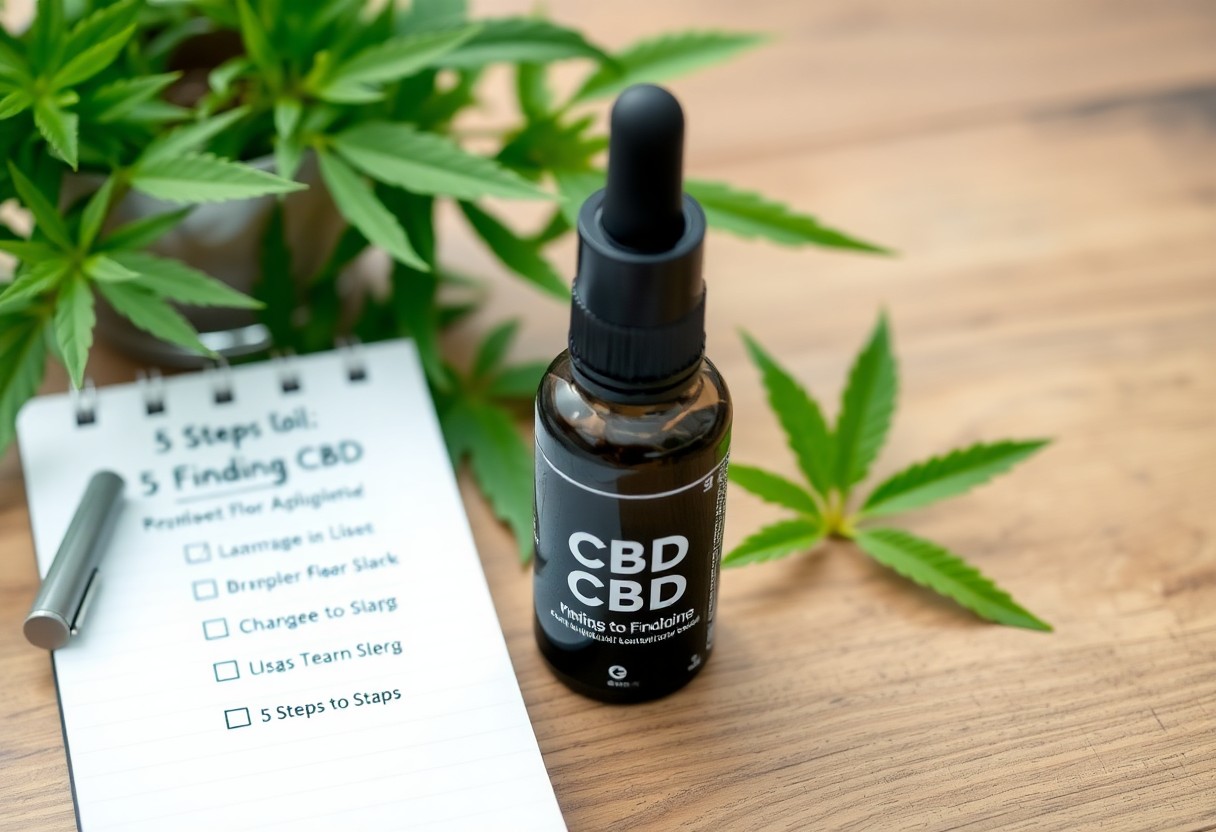5 Steps To Finding The Best CBD For Pain Relief

Relief from chronic pain can often feel elusive, but exploring the right CBD options can make a significant difference in your wellness journey. In this comprehensive guide, you’ll discover five crucial steps to identify the best CBD products tailored to your needs. Whether you’re a seasoned user or new to CBD, you’ll gain valuable insights to help you make informed decisions about pain management. Let’s investigate the crucial factors that will empower you to find effective relief through CBD.
Key Takeaways:
- Research the different types of CBD products available, such as oils, capsules, and topicals, to determine which form best suits your needs.
- Potency is important; choose a CBD product with the right concentration to effectively alleviate your pain.
- Source of the CBD matters—opt for products derived from organic hemp to ensure quality and purity.
- Third-party testing is vital for verifying the product’s safety and effectiveness, so check lab results before purchasing.
- Consult with a healthcare professional to tailor your CBD journey and address any potential interactions with existing medications.
Understanding CBD
Before you investigate selecting the best CBD for pain relief, it’s important to understand what CBD is and how it works. Cannabidiol (CBD) is a naturally occurring compound found in the hemp plant. Unlike its more famous counterpart, THC (tetrahydrocannabinol), CBD does not produce a psychoactive effect, meaning it won’t make you feel “high.” Instead, it offers potential therapeutic benefits, which many people are turning to for various ailments, including pain. For a detailed guide on Finding the Best CBD:THC Ratios and Products for Pain, check out this helpful resource: Finding the Best CBD:THC Ratios and Products for Pain.
What is CBD?
About 60 different compounds make up CBD, which belongs to a larger class of compounds known as cannabinoids. These cannabinoids interact with your body’s endocannabinoid system, which plays a role in regulating various physiological processes such as immune response, sleep, and pain sensation. When you consume CBD, it binds to receptors in the endocannabinoid system, potentially modulating these processes and offering relief from discomfort without the undesirable psychoactive effects associated with THC.
How Does CBD Work for Pain Relief?
On a biological level, CBD may help manage pain through various mechanisms. It is believed to inhibit the transmission of pain signals in the nervous system and reduce inflammation, which can be a significant source of pain for many individuals. Additionally, CBD’s interaction with the endocannabinoid system might enhance your resilience to stress and anxiety, both of which can exacerbate your experience of pain.
But it’s important to note that while many users report positive effects from CBD, research is still ongoing to fully understand its efficacy and mechanisms for pain relief. Individual responses to CBD can vary widely, influenced by factors like dosage, method of consumption, and your unique physiological makeup. So, as you explore the best options for your pain management, consider these variables for a more personalized approach.
Identifying Your Pain Type
You need to understand the nature of your pain to find effective relief. Pain can be broadly classified into two categories: chronic and acute. Recognizing which type of pain you are experiencing is important for determining the most suitable treatment options, including the right CBD products for your needs.
Chronic vs. Acute Pain
At the forefront of identifying your pain type is understanding the distinction between chronic and acute pain. Acute pain typically lasts for a short duration and is often a direct response to an injury or medical condition, resolving once the underlying issue is treated. In contrast, chronic pain persists for an extended period—often defined as lasting longer than three to six months—and can arise from conditions such as arthritis or fibromyalgia, sometimes even without an identifiable cause.
Conditions That May Benefit from CBD
Type of pain you experience can influence not only your daily life but also your treatment options. CBD has gained recognition for its potential benefits in managing various conditions, including chronic pain syndromes, inflammatory disorders, and conditions like multiple sclerosis. The non-intoxicating properties of CBD make it an appealing alternative for those seeking to alleviate pain without the psychoactive effects associated with traditional cannabis products.
Benefit from utilizing CBD may extend to a range of conditions that affect your quality of life. Research indicates that individuals dealing with arthritis, migraines, and neuropathic pain may find relief through CBD formulations. The versatility of CBD products, from oils to creams, allows you to tailor your approach based on specific symptoms and personal preference, ensuring you maximize the potential benefits in managing your pain.
Researching Quality CBD Products
Not every CBD product on the market offers the same level of quality. When searching for the right product to alleviate your pain, you should invest time in research to find reputable brands that prioritize transparency and quality in their offerings. It’s crucial to review ingredients, sourcing methods, and production processes to ensure that you are selecting a product that aligns with your health needs and expectations. This foundational research can pave the way to discovering effective solutions that truly work for you.
Lab Testing and Certifications
Below the surface of any quality CBD product lies extensive laboratory testing and certifications. Reliable manufacturers will have their products third-party tested to verify the potency and purity of their CBD. This testing not only checks for the concentration of cannabinoids but also screens for harmful contaminants like pesticides, heavy metals, and residual solvents. Always look for products that provide clear lab results, often available on their websites or through a QR code on the packaging.
Understanding CBD Concentration
By getting a grasp on CBD concentration, you allow yourself to make better-informed choices about which product may be right for your pain management. CBD concentration is typically listed in milligrams (mg) on the label, indicating how much CBD is contained within the entire product or serving size. Higher concentrations may lead to more significant effects, but this can vary based on individual body chemistry, pain levels, and tolerance. It’s beneficial to start with a lower concentration and gradually increase as needed while monitoring your body’s response.
Quality CBD products take your specific needs into account, offering varying concentrations to match your situation. With a clear understanding of how much CBD you require, you can fine-tune your dosages and find the optimal product to alleviate your pain effectively. Don’t hesitate to experiment with different concentrations, as what works best for you may take a little time to discover.
Choosing the Right CBD Format
Once again, finding the best CBD for pain relief involves understanding the various formats available. Each format comes with its own unique characteristics, making it necessary to select one that aligns with your lifestyle and personal preferences. Whether you prefer a quick-acting method, a long-lasting solution, or something easy to incorporate into your daily routine, identifying the right format can significantly influence your experience and effectiveness in managing pain. You’ll find that oils, tinctures, edibles, and topicals each offer distinct advantages and drawbacks that can cater to your specific needs.
Oils, Tinctures, Edibles, and Topicals
Around the landscape of CBD products, oils and tinctures tend to be favored for their flexibility and rapid absorption. They can be taken sublingually for quick relief or added to food and drinks as needed. On the other hand, edibles, such as gummies and capsules, are a popular choice for those looking for a more enjoyable, discreet way to consume CBD. They provide a delicious alternative but may take longer to take effect. Lastly, topicals, like creams and balms, are specifically designed for localized pain relief, targeting specific areas almost immediately.
Pros and Cons of Each Format
About understanding your options further, evaluating the pros and cons of each CBD format can help you make an informed decision. Each option suits different preferences and pain management tactics, so consider both the benefits and limitations before settling on a format. Take a look at the table below for a breakdown of the pros and cons of oils, tinctures, edibles, and topicals.
Pros and Cons of Each Format
| Format | Pros | Cons |
|---|---|---|
| Oils | Quick absorption; adjustable dosage | Possibly strong taste; may require measuring |
| Tinctures | Fast onset; easy to use | Alcohol-based may not be palatable for everyone |
| Edibles | Discreet; variety of flavors | Longer onset time; fixed dosage |
| Topicals | Localized relief; easy application | Limited to surface-level relief; may take time to work |
Even when you’ve narrowed down your preferred CBD format, understanding the nuances can still play a big part in your overall experience. Each method of consumption may lead to different effects based on how your body metabolizes CBD and your individual pain level. By weighing the unique pros and cons of oils, tinctures, edibles, and topicals, you can better tailor your choice to suit your needs and achieve the optimal pain relief you’re seeking.

Determining the Right Dosage
After deciding to incorporate CBD into your pain relief regimen, it’s important to determine the right dosage for your needs. The correct dosage will vary greatly between individuals based on several factors. You need to understand that what works for one person may not yield the same results for you, making it vital to consider personal attributes and circumstances when selecting your dosage of CBD.
Factors Influencing Dosage
About finding that optimal dosage, several key factors come into play. These can significantly influence how CBD interacts with your body and the effectiveness of the relief you seek. Consider the following aspects:
- Your body weight
- The severity of your pain
- Your individual tolerance to CBD
- The method of delivery (oils, edibles, topicals, etc.)
- The concentration of CBD in your chosen product
Assume that all these aspects are foundational to pinpointing the dosage that provides the best results for you.
Starting Low and Going Slow
Before entering into high dosages of CBD, it’s advisable to start with a low dose and gradually increase it over time. This approach allows you to gauge how your body responds to CBD and minimizes the risk of experiencing any potential side effects. By beginning with a conservative amount, you can make adjustments based on your pain levels and overall wellness without overwhelming your system.
Another important element to keep in mind while starting low and going slow is the patience required in this process. It may take a few days or even weeks to find the dosage that offers you the best pain relief. By monitoring your body’s reaction closely and making incremental adjustments, you can establish a routine that suits your personal needs and delivers the pain relief you are looking for.
Consulting with Healthcare Professionals
Keep in mind that navigating the world of CBD for pain relief can be complex, and seeking medical guidance is crucial. Consulting with healthcare professionals not only enhances your understanding of potential therapies but also ensures that your choices align with your overall health strategy. A knowledgeable doctor can evaluate your individual health circumstances, medications, and potential interactions, guiding you to safe and effective use of CBD. This professional insight can prove invaluable as you commence on your journey toward pain management.
Importance of Medical Guidance
Consulting a healthcare provider plays a significant role in making informed decisions about CBD. Your medical professional can help assess your specific pain conditions and recommend whether CBD may be a suitable option for you. It’s also an opportunity to discuss any alternative treatments or lifestyle changes that could complement your pain management plan. By involving your doctor, you are taking proactive steps toward ensuring that your approach to relieving pain is safe and tailored specifically to your needs.
Questions to Ask Your Doctor
For a productive conversation with your doctor, it’s crucial to prepare a set of relevant questions regarding CBD use for pain relief. Start by inquiring about the potential benefits and risks of incorporating CBD into your regimen. You may want to ask how CBD could interact with any existing medications, or if there are specific types of CBD products that they recommend based on your health profile. Additionally, discussing the appropriate dosages and forms of CBD can provide valuable insights as you consider this option.
Due to the variances in individual health conditions, it’s wise to be specific when discussing CBD with your healthcare provider. You might ask about the signs to monitor while using CBD, the timeframe in which you might expect to see results, and any alternative treatment options that could be beneficial alongside or instead of CBD. Collecting this information allows you to create a comprehensive plan tailored to your needs, maximizing your chances for effective pain management.
To Wrap Up
Taking this into account, you now have a clear pathway to finding the best CBD product for your pain relief needs. By understanding the importance of sourcing high-quality CBD, considering various product forms, evaluating potency, and exploring third-party testing, you empower yourself to make informed decisions. Each of these steps plays a vital role in ensuring that you select a product that is both effective and safe, tailored to your specific situation and method of consumption.
Ultimately, the journey to discovering the right CBD for your pain management doesn’t have to be overwhelming. With the knowledge gained from this guide, you can approach the numerous options available in the market with confidence. The right CBD product is out there for you, and by following these five steps, you’ll be well on your way to enhancing your wellness and finding effective relief from pain.
FAQ
Q: What are the key factors to consider when selecting CBD for pain relief?
A: When choosing CBD for pain relief, consider the source of the hemp, extraction methods, cannabinoid profiles, third-party lab testing, and the product’s form (such as oils, capsules, or topicals). Ensure the product is derived from high-quality hemp and that it undergoes rigorous testing to verify potency and purity.
Q: How does the method of consumption affect CBD’s effectiveness for pain relief?
A: The method of consumption can significantly influence how quickly and effectively CBD alleviates pain. Inhalation methods, like vaping or smoking, often provide quicker relief, whereas edibles or capsules take longer to kick in but may offer prolonged effects. Topicals, on the other hand, are ideal for localized pain relief.
Q: Is there a specific dosage of CBD recommended for pain relief?
A: There is no one-size-fits-all dosage for CBD, as it varies depending on individual factors such as body weight, metabolism, and pain severity. It is generally advised to start with a low dose and gradually increase until you find the optimal level that provides relief without adverse effects.
Q: Are there any side effects associated with using CBD for pain relief?
A: While CBD is considered safe for most individuals, some may experience mild side effects such as fatigue, diarrhea, changes in appetite, or dry mouth. It is advisable to consult with a healthcare provider before starting CBD, especially if you are taking other medications.
Q: How long does it typically take to feel the effects of CBD for pain relief?
A: The onset of effects from CBD can vary widely based on the method of consumption. Inhaled products may produce effects within minutes, while edibles or capsules may take 30 minutes to 2 hours to feel the results. Topicals can provide localized relief fairly quickly, depending on the formulation.













